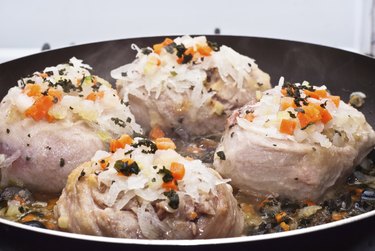
It's a truism of the kitchen that the tenderest meat is found on the youngest animals, which is why lamb, veal and tender young chickens are more delicate than their mature counterparts. That being said, some cuts -- such as veal shanks -- are tough even though they're taken from young, tender animals, and require careful handling as a result. In exchange for that modest degree of extra effort, veal shanks yield a richer, deeper flavor than other cuts of veal.
A Brief Introduction
Video of the Day
A single bull is all that's needed to service a large number of cows, so most veal comes from surplus male calves. They're harvested at about 16 to 18 weeks of age, yielding small cuts with a pale pink color and delicate flavor. Most muscles toughen with age and use, so -- as with lamb -- young veal is uniformly tender. The exception to that rule is the shanks, the shin portions of the front and hind legs. These are filled with dense muscles and chewy connective tissues even in young animals, because they anchor the remaining leg muscles and are therefore used constantly.
Video of the Day
Tough Love
Paradoxically, those muscles and tough connective tissues are precisely the reason for veal shanks' popularity. The dense, well-worked muscles develop more flavor than you'll find in other cuts of veal, and the shanks' generous quantities of bone and connective tissue are filled with natural gelatin. If the shank is slow-cooked long enough, the bonds between those muscle fibers will soften and relax. The natural gelatin from the bones and tendons melts, moistening the shanks' flesh and endowing it with a lush, rich mouthfeel. The end result is a deeply flavorful dish.
Choosing Your Cuts
Veal shanks are taken from both the front and rear legs, and are referred to respectively as foreshanks and hindshanks. Your local supermarket or butcher's shop won't always differentiate between them, but in general the hindshanks are larger and meatier. Shanks are usually cut, for retail sale, into steaklike rounds, a convenient form for preparing braised dishes such as the Italian classic, osso buco. You may occasionally see shanks sold whole, as well. "Frenched" hindshanks make an especially striking meal, though you'll usually need to special-order them. The ankle portion of the shank is cut away, leaving a thick round of meat at the bottom with a well-cleaned bone at the top.
Cooking Your Shank
Shank can't be hurried. It must be cooked gently, either slow-roasted or braised. Roast your shanks in the oven on Low, ideally 275 to 300 degrees Fahrenheit, in a covered pan containing a splash of broth or wine for moisture. To braise the shanks, brown them first and then simmer them under a layer of broth in your oven or slow cooker for 3 to 4 hours, until they're fork-tender. The cooking liquid can be strained and thickened, producing a rich sauce to accompany the veal. Allow 1 or 2 slices of shank per person, or cook your shanks whole to serve 2 to 4 diners.